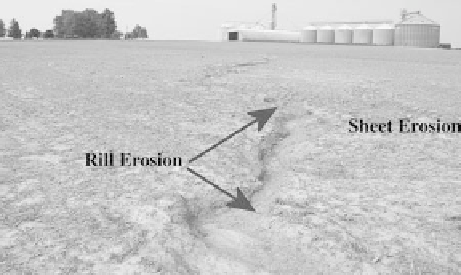Agriculture Reference
In-Depth Information
Calcium and magnesium are both important in crop production; the amounts avail-
able are related to both the pH and the CEC. In addition, the ratio of calcium to mag-
nesium needs to be within a certain range for optimum crop growth. Both of these
elements are found in limestone, which is generally ground to produce lime for correc-
tion of acid soil conditions.
The other column in Table 9.5 refers to micronutrients, such as zinc (Zn), copper
(Cu), iron (Fe), selenium (Se), manganese (Mn), molybdenum (Mo), and so forth and
may include and specify any of them. In general, micronutrient analysis is relatively
more expensive than the analysis for the other nutrient elements, and so it is done spar-
ingly and only when observation of plants leads one to believe that there is a
micronutrient deficiency.
9.9
SOIL EROSION
Soil erosion is a worldwide problem that negatively impacts crop production. There
are two types of soil, erosion, geologic and accelerated. Geologic erosion is the
natural loss of soil that occurs even on the best vegetated soils and is a natural
phenomenon. Accelerated erosion occurs most often on sloping bare soil and is
caused by either wind or water passing over a bare field; see Figure 9.11. Soil loss
is greater than geologic erosion and is most important and most damaging to crop
production if not controlled.
Accelerated erosion occurs as a result of agricultural practices and to a lesser extent
as a result of construction. Any soil without vegetative, plant residue or other cover is
subject to accelerated erosion. During traditional cultivation, plowing, disking, and
planting, the soil is most subject to accelerated erosion. Once the crop has canopy
closure, the time when the leafy tops of crops completely shade the ground, the
threat of erosion is greatly reduced.
Raindrops striking a bare soil surface dislodge soil particles, break up soil peds,
and thus allow these particles to be removed from the field. The process of raindrop
Figure
9.11.
Gully erosion caused by rain on a field not protected by a growing crop or crop
residue. (Courtesy of Mathew Deaton.)









